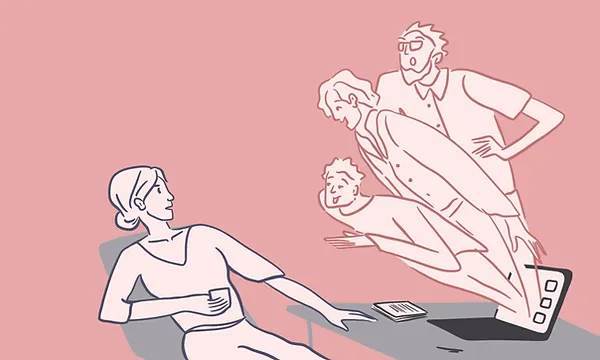John Berg begins his book, Ways of Seeing, by writing, ‘Seeing comes before words. The child looks and recognizes before it can speak.’ Recently, there has been a buzzword called “the gaze”. And it’s basically called the “male gaze” with the prefix “male”. Imagine this scenario: you’re shopping in a clothing shop and a short pink dress looks good and compliments the lines of your body nicely, but you think it’s too short and you might suffer comments from your colleagues. In the end, you opt for a beige dress; it’s simple, generous and elegant in tone, and it makes you look feminine without being overly bold. The way you look in the mirror seems to represent many kinds of judgmental voices from the outside world. You look beautiful now because someone is probably watching, judging — you feel the presence of the male gaze.
So what exactly is the male gaze?
British feminist film theorist Laura Mulvey describes the concept of the “male gaze” in her article in the film theory journal Screen (published in 1973). In the article, Mulvey, who is a professor of film and media studies at Birkbeck, University of London, explained the way that mainstream media objectifies women, showing the female body through a heterosexual male lens as a passive non-actor secondary to the active male characters. Fundamentally, the male gaze views the female body as something to be viewed, conquered, owned, and used by heterosexual males (or patriarchal society as a whole) to further their ends. As an example, there are the classic male gaze phrases such as ‘you have such a great body, you must have a lot of boys like you’ or ‘your boyfriend must be very happy’.
The concept of the male gaze, which originated in the cinema, has had a profound effect on advertising, women in advertising are not just objects to be gazed at, they are objects to be bought and sold. The message is always the same: buy the product and you get the girl or buy the product and you become like the girl in the advert to get your man, in other words, buy the image, “get the girl”. In other words, buy the “image”, “get the girl”.
How to confront the male gaze?
In short, the question isn’t whether women can dress, pose, or express themselves the way they want to – the answer to that is an obvious yes. There should be no shame in dressing provocatively and owning your sexuality. Furthermore, it can be argued that when girls and women deliberately choose to dress this way, they can partially reclaim their bodies. Especially when they do so deliberately with full knowledge of history.
‘Ultimately, the male gaze is a social construct that we can disarm by recognizing it and choosing to either tolerate or ignore it—or intentionally take it on and recalibrate it as your own, co-opting its power to define your sexuality, agency, and worth on your own terms.’ (from verywell)
Reference list
Berger, J. (1972). Chapter 1 of Ways of Seeing by John Berger. [online] Ways-of-seeing.com. Available at: https://www.ways-of-seeing.com/ch1.
Mulvey, L. (1975). Visual Pleasure and Narrative Cinema. Screen, 16(3), pp.6–18.
Verywell Mind. (n.d.). What Is the Male Gaze? [online] Available at: https://www.verywellmind.com/what-is-the-male-gaze-5118422#citation-12.


I don’t think choosing to tolerate and ignore the male gaze is a good way to go; the male gaze is inherently a social vice that should be condemned because sex is offensive. Gazing may be a joke in the eyes of some males, but in the case of females it may be the unspeakable that life cannot bear. In fact, this phenomenon will only really disappear if the male gaze is not disregarded, if women wake up and fight back, and if men are motivated to learn to respect women and reach a consensus on gender equality.
I really enjoyed the way you explained the male gaze and it’s effect on the media and society however I do disagree with the quote at the end. “Tolerating” or “Ignoring” injustice isn’t how progress is made especially when it comes to mass media where the male gaze and sexism is so prominent. I believe the male gaze should be talked about more often in media analysis- critiquing it and bettering both ourselves and the industry so objectification and other aggressions become less prominent in future.
In fact, the male gaze and the female gaze have always existed and are not going away at this stage. In this case, when the male gaze occurs, it is actually a violation of a woman’s autonomy (for example, when a man is looking at a woman in a hostile way on the road). If power cannot be guaranteed, none of us should ignore and tolerate such behavior. If we do nothing, more women will be hurt.
The notion of the ‘man gaze’ discussed in this blog corresponds to the widespread objectification of women in both the media and society. The text astutely elucidates the manner in which this gaze, originating from the film, has permeated advertisements, portraying women not alone as objects of admiration, but also as commodities to be purchased and traded. The initiative to challenge the male gaze include promoting consciousness, enhancing media literacy, embracing many modes of artistic representation, and empowering women to genuinely articulate their thoughts and emotions. The blog appropriately highlights the significance of questioning conventional gender conventions and aesthetic standards. In summary, it offers a persuasive examination of a crucial matter, pushing for a society that is more inclusive and fair.